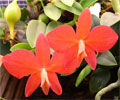|
|
|
|
|
| |
Flasks of
Sophronitis wittigiana 'MC2935' × self |
|
| |
|
|
| |
| Number: |
TN4758 |
| Name: |
Sophronitis wittigiana 'MC2935' × self
|
| Type: |
self (What's that?) |
|
Seed Donor: |
Zachary Bittner
|
|
Click to Enlarge

Pod Parent Flowers |
|
|
|
| |
Culture Notes from Donor: Parent plant: Temperature range CI (58-75°F). It prefers high humidity and light watering. This species should be grown on a cork mount and should be allowed to dry out between watering. It DOES NOT like to remain wet. Easy grower for this genus.
Comments: Parent plant: Miniature. This plant is a very consistent and steady grower. It is very typical of this species as a whole. The flowers are more salmon-colored than is typical. This species is very similar to, though distinct from S. brevipedunculata.
For additional origin/habitat information supplied courtesy of
Charles and Margaret Baker, see further below, near the bottom of this page.
|
Temperatures we attempt to use in the lab & greenhouse:
| For Species: |
|
Spring, Summer, Autumn: days average 75°F, nights 58°F; best fit is Cool-Intermediate 75-58°F
(Source:
Baker's Web OSC) |
| For Species: |
|
Winter: days average 68°F, nights 47°F; best fit is Cool-Cold 64-44°F
(Source:
Baker's Web OSC) |
|
About the name...
| Etymology of |
sophronitis |
|
From latinized Greek "sophros" modest.
(Source:
Mayr & Schmucker 1998) |
| Etymology of |
wittigiana |
|
Named for Wittig, German plant collector in Brazil, during the 2nd half of the 19th century.
(Source:
Mayr & Schmucker 1998) |
| Pronunciation of |
sophronitis |
|
sof-row-NYE-tis
(Source:
Hawkes 1978) |
|
If you would like to direct someone to this web page, please copy and paste this URL into your email:
http://troymeyers.com/d?014758
| Flask Information |
| Availability: |
We have sold all of the flasks for this item. |
| You should: |
Consider getting individual plants or compots instead of a flask.
You can place a "Notify Flask Recipients" Request, and either we or a flask recipient may contact you when plants are available.
You may also place a "Notify Retries" Request, and if an identical pollination (the same parents) is done again, we'll let you know.
You may reserve a flask, but it's very unlikely you'll get one ...this could only happen if we found a flask that we didn't know we had. |
| Yield Estimate: |
350 plants (based on flask surveys done 05/03/2005 through 02/14/2006)
|
| Plantlet Sizes: |
From many flasks 3 - 45 mm plants (based on flask surveys done 05/03/2005 through 11/02/2006)
From one most recently surveyed flask 20 - 30 mm (11/02/2006)
|
|
You might also want to:
|
View the seed assay for this item.
View items of the same species.
View items of the same genus.
|
| Ordering Information |
| You are not currently logged in. |
|
You must be a registered user and be logged in to reserve a flask or place a notification request. Please log in:
|
|
|
|
|
|
| |
The origin/habitat information below is supplied courtesy of Charles and Margaret Baker
The following information is based on the name of the plant provided by the donor, and assumes that the name is correct. If the plant has been misidentified, then the following information may not be correct.
This text is copyrighted by the Bakers and may not be reproduced without permission.
ORIGIN/HABITAT: Brazil. Plants are found in the interior mountains of the
state of Espirito Santo from the slopes of the Caparao to east of Pedra
Azul and north to about Mantena, where the country becomes too dry.
Plants, which are generally found at 3500-4500 ft. (1070-1370 m), have
been reported at elevations as low as 2300 ft. (700 m) and as high as 6550
ft. (2000 m). They most often grow on rough-barked trees that are thickly
coated with dense, epiphytic mosses described as being "wringing wet".
Although plants most often grow on the upright trunks of these trees, they
are also found on the horizontal branches.
The trees on which Sophronitis wittigiana grows most often are in the
brighter light 100-300 ft. (30-90 m) up the steep slopes on either side of
the floor of what Dr. Fowlie (1987) refers to as "gully swamps" and the
McQueens (1992 and 1993) call "deep swampy gorges". Plants may also be
found in the uppermost branches of trees growing on the swampy floor of
the gorge, however. These swamps were formed when runoff from extremely
heavy rainfall cut deep, wide canyons between ridges on either side. Lakes
or ponds formed when the streams through the gorges became dammed or their
flow restricted by vegetation washed down by the torrents, and the humus
that ultimately accumulated resulted in the development of deep deposits
of peat across the floors of these gorges. The moisture collected and held
by the peat during the rainy season keeps humidity high year-round and is
available to plants in the area as condensation from heavy dews and mist
during the dry season.
More about this information and the Bakers...
|
|
|
| |
|
|
|